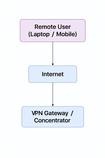TTL / Hop Limit
- Author Ermias Teffera
- Sep 24, 2015
- 2 min read
Time to Live (TTL) or hop limit, is a mechanism that limits the lifespan or life of data in networking, The designers of TCP/IP realizes that it would be possible for an IP packet to circulate endlessly on a network. For any given point to to point network R1 ends up sending the packet to R2 which thinks sending back to R1 is the right way to go will make the packet go, In simple point to point environment if the routers has an inappropriate instruction they could circulate the packet endlessly This would get much worse of course as more packet enters the routers. So they come up with a solution with a TTL field in the IP header.
The TTL field in an IP header is a eight bit field that utilizes TTL in the IP protocol, If you have eight bits you will have a maximum value of 255, So what they decided to do was routers decrements this value at each router hop, so as each router is forwarding the packet it takes this TTL value and it decrements it, if a router gets an IP packet and the TTL value is Zero (0) it realizes that packet has been on the network for long time and it will discard that particular packet.
In IPV6 the TTL header is changed to hop limit, I will create a topology, to show you how the TTL decrements as it travels from hop to hop on both IPV4and IPV6.

Showing the IPV4 route table on R1.



Wireshark capture as the first ping travels from R1 to R2 which happens to be packet number 8. TTL is now 255.
Showing the IPV6 route table on R1

Wireshark packet capture as the ping traveles from R2 to R3, Packet number 5. TTL is now 254.

Packet capture as packet travels from R3 to R4, packet number 4, TTL is now 253.

Pinging IPV6 address of R4's fa2/0 segment from R1

IPV6 packet capture as the first ping travels from R1 to R2, TTL is now 64.

PV6 packet capture as the first ping travels from R2 to R3, TTL is now 63.
IPV6 packet capture as the first ping travels from R3 to R4, TTL is now 62.











Comments